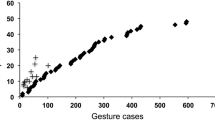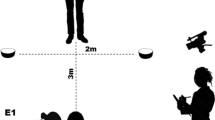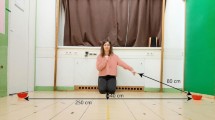Abstract
We investigated whether dogs and 2-, and 3-year-old human infants living, in some respects, in very similar social environments are able to comprehend various forms of the human pointing gesture. In the first study, we looked at their ability to comprehend different arm pointing gestures (long cross-pointing, forward cross-pointing and elbow cross-pointing) to locate a hidden object. Three-year-olds successfully used all gestures as directional cues, while younger children and dogs could not understand the elbow cross-pointing. Dogs were also unsuccessful with the forward cross-pointing. In the second study, we used unfamiliar pointing gestures i.e. using a leg as indicator (pointing with leg, leg cross-pointing, pointing with knee). All subjects were successful with leg pointing gestures, but only older children were able to comprehend the pointing with knee. We suggest that 3-year-old children are able to rely on the direction of the index finger, and show the strongest ability to generalize to unfamiliar gestures. Although some capacity to generalize is also evident in younger children and dogs, especially the latter appear biased in the use of protruding body parts as directional signals.





Similar content being viewed by others
References
Albert A, Bulcroft K (1987) Pets and urban life. Anthrozoos 1:9–25
Albert A, Bulcroft K (1988) Pets, families, and the life course. J Marriage Fam 50:543–552
Allan LG (1993) Human contingency learning: rule based or associative? Psychol Bull 114:435–448
Anderson JR, Sallaberry P, Barbier H (1995) Use of experimenter-given cues during object choice tasks by capuchin monkeys. Anim Behav 49:201–208
Behne T, Carpenter M, Tomasello M (2005) One-year-olds comprehend the communicative intentions behind gestures in a hiding game. Dev Sci 8:492–499
Bräuer J, Kaminski J, Riedel J, Call J, Tomasello M (2006) Making inferences about the location of hidden food: Social dog–causal ape. J Comp Psychol 120:38–47
Brownell CA, Ramani GB, Zerwas S (2006) Becoming a social partner with peers: cooperation and social understanding in one- and two-year-olds. Child Dev 77:803–821
Butterworth GE, Grover L (1998) Joint visual attention, manual pointing, and preverbal communication in human infancy. In: Jeannerod M, Hillsdale NJ (eds) Attention and performance. Erlbaum, Hillsdale
Cain AO (1985) Pet as family members. In: Sussman A (ed) Pets and the family. The Haworth Press, New York, pp 5–10
Call J, Hare B, Tomasello M (1998) Chimpanzee gaze following in an object choice task. Anim Cogn 1:89–100
Call J, Agnetta B, Tomasello M (2000) Cues that chimpanzees do and do not use to find hidden objects. Anim Cogn 3:23–34
Dobrich L, Scarborough A (1984) Form and function in early communication. Language and pointing gestures. J Exp Child Psychol 38:475–490
Evans CS (1997) Referential signals. In: Owings DH, Beecher MD, Thompson NS (eds) Perspectives in ethology, communication, vol 12. Plenum Press, New York, pp 99–143
Frank H (1980) Evolution of canine information processing under conditions of natural and artificial selection. Z Tierpsychol 53:389–399
Gácsi M, Győri B, Miklósi Á, Virányi Z, Kubinyi E, Topál J, Csányi V (2005) Species-specific differences and similarities in the behavior of hand raised dog and wolf puppies in social situations with humans. Dev Psychobiol 47:111–122
Gácsi M, Kara E, Belényi B, Topál J, Miklósi Á (2009) The effect of development and individual differences on pointing comprehension in. Anim Cogn. doi:10.1007/s10071-008-0208-6)
Hare B, Tomasello M (1999) Domestic dogs (Canis familiaris) use human and conspecific social cues to locate hidden food. J Comp Psychol 113:173–177
Hare B, Brown M, Williamson C, Tomasello M (2002) The domestication of social cognition in dogs. Science 298:1634–1636
Herman LM, Abichandani SL, Elhajj AN, Herman EYK, Sanchez JL, Pack AA (1999) Dolphins (Tursiops truncatus) comprehend the referential character of the human pointing gesture. J Comp Psychol 113:347–364
Hirsch-Pasek K, Treiman R (1981) Doggerel: motherese in a new context. J Child Lang 9:229–237
Itakura S, Tanaka M (1998) Use of experimenter-given cues during object-choice tasks by chimpanzees (Pan troglodytes), an orangutan (Pongo pygmaeus), and human infants (Homo sapiens). J Comp Psychol 112:119–126
Jenkins WO (1943) A spatial factor in chimpanzee learning. J Comp Psychol 35:81–84
Leavens DA, Hopkins WD (1999) The whole-hand pointing: the structure and function of pointing from a comparative perspective. J Comp Psychol 113:417–425
Leung EHL, Rheingold HL (1981) Development of pointing as a social gesture. Dev Psychol 17:215–220
McKinley J, Sambrook TD (2000) Use of human-given cues by domestic dogs (Canis familiaris) and horses (Equus caballus). Anim Cogn 3:13–22
Miklósi Á, Soproni K (2006) A comparative analysis of the animals’ understanding of the human pointing gesture. Anim Cogn 9:81–93
Miklósi Á, Polgárdi R, Topál J, Csányi V (1998) Use of experimenter-given cues in dogs. Anim Cogn 1:113–121
Miklósi Á, Kubinyi E, Topál J, Gácsi M, Virányi Z, Csányi V (2003) A simple reason for a big difference: wolves do not look back at humans but dogs do. Curr Biol 13:763–766
Miklósi Á, Topál J, Csányi V (2004) Comparative social cognition: what can dogs teach us? Anim Behav 67:995–1004
Miklósi Á, Pongrácz P, Lakatos G, Topál J, Csányi V (2005) A comparative study of the use of visual comminicative signals in interactions between dogs (Canis familiaris) and humans and cats (Felis catus) and humans. J Comp Psychol 119:179–186
Milgram NW, Adams B, Callahan H, Head E, Mackay B, Thirlwell C, Cotman CW (1999) Landmark discrimination learning in the dog. Learn Memory 6:54–61
Mitchell RW (2001) Americans’ talk to dogs: similarities and differences with talk to infants. Res Lang Soc Interact 34:183–210
Morisette P, Ricard M, Decarie TG (1995) Joint visual attention and pointing in infancy: a longitudinal study of comprehension. Br J Dev Psychol 13:163–175
Murphy JV, Miller RE (1955) The effect of spatial contiguity of cue and reward in the object-quality learning of rhesus monkeys. J Comp Physiol Psychol 48:221–224
Pongrácz P, Miklósi A, Csányi V (2001) Owners’ beliefs on the ability of their pet dogs to understand human verbal communication. A case of social understanding. Curr Cogn Psychol 20:87–107
Povinelli DJ, Reaux JE, Bierschwale DT, Allain AD, Simon BB (1997) Exploitation of pointing as a referential gesture in young children, but not adolescent chimpanzees. Cogn Dev 12:423–461
Povinelli DJ, Bierschwale DT, Cech CG (1999) Comprehension of seeing as a referential act in young children, but not juvenile chimpanzees. Br J Dev Psychol 17:37–60
Prato-Previde E, Fallani G, Valsecchi P (2006) Gender differences in owners interacting with pet dogs: an observational study. Ethology 112:64–73
Rasmussen JL, Rajecki DW (1995) Differences and similarities in humans’ perceptions of the thinking and feeling of a dog and a boy. Soc Anim 3:117–137
Scheumann M, Call J (2004) The use of experimenter-given cues by South African fur seals (Arctocephalus pusillus). Anim Cogn 7:224–230
Shapiro AD, Janik VM, Slater PJB (2004) A grey seal’s (Halichoerus grypus) responses to experimenter-given pointing and directional cues. J Comp Psychol 117:355–362
Soproni K, Miklósi Á, Topál J, Csányi V (2001) Comprehension of human communicative signs in pet dogs (Canis familiaris). J Comp Psychol 115:122–126
Soproni K, Miklósi Á, Topál J, Csányi V (2002) Dogs’ (Canis familiaris) responsiveness to human pointing gestures. J Comp Psychol 116:27–34
Tomasello M, Camaioni L (1997) A comparison of the gestural communication of apes and human infants. Hum Dev 40:7–24
Tomasello M, Call J, Gluckman A (1997) Comprehension of novel communicative signs by apes and human children. Child Dev 68:1067–1080
Tomasello M, Carpenter M, Call J, Behne T, Moll H (2005) Understanding and sharing intentions: the origins of cultural cognition. Behav Brain Sci 28(5):675–691
Topál J, Miklósi Á, Csányi V, Dóka A (1998) Attachment behavior in dogs (Canis familiaris): a new application of Ainsworth’s (1969) strange situation test. J Comp Psychol 112:219–229
Tschudin A, Call J, Dunbar RIM, Harris G, van der Elst C (2001) Comprehension of signs by dolphins (Tursiops truncatus). J Comp Psychol 115:100–105
Virányi Zs, Gácsi M, Kubinyi E, Topál J, Belényi B, Ujfalussy D, Miklósi Á (2008) Comprehension of human pointing gestures in young human-reared wolves and dogs. Anim Cogn 11:373–387
Wilkins D (2003) Why pointing with the index finger is not a universal (in sociocultural and semiotic terms). In: Kita S (ed) Pointing: where language, culture, and cognition meet. Erlbaum, Hillsdale, pp 171–215
Acknowledgments
This study was supported by grants received from the Hungarian Science Fund (OTKA T049615), the Hungarian Academy of Sciences (F01/031) and an EU FP6 NEST 012787 grant. The authors are grateful to all the parents and the owners who participated in this research for their patience and support throughout the study. The experiments delineated in this manuscript comply with the current Hungarian laws.
Author information
Authors and Affiliations
Corresponding author
Rights and permissions
About this article
Cite this article
Lakatos, G., Soproni, K., Dóka, A. et al. A comparative approach to dogs’ (Canis familiaris) and human infants’ comprehension of various forms of pointing gestures. Anim Cogn 12, 621–631 (2009). https://doi.org/10.1007/s10071-009-0221-4
Received:
Revised:
Accepted:
Published:
Issue Date:
DOI: https://doi.org/10.1007/s10071-009-0221-4




